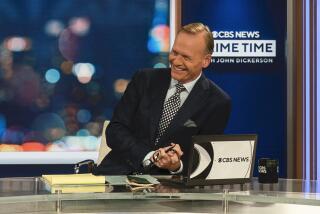COMMENTARY : Dan and Connie: Between the Lines
- Share via
As it happens, the pairing of Dan Rather and Connie Chung as co-anchors of the “CBS Evening News” was announced just three days after NBC said that Tom Brokaw and Katie Couric will co-host a prime-time newsmagazine this fall.
There is clearly more at work here than the healthy ascension of several more women to the rarefied top levels of network news, at least on-camera. Among other things, the link between top news anchors and the growing profit center of prime-time newsmagazines is becoming more pronounced as the networks seek every opportunity to stay afloat.
Rather already hosts the increasingly popular “48 Hours.” Chung, who failed with a past CBS newsmagazine, will try another, “Eye to Eye.” Brokaw, of the “NBC Nightly News,” and Couric, of the “Today” show, now will jump into the prime-time fray with the tentatively titled, weekly one-hour series “NBC News Magazine.”
The cross-promotion possibilities, of course, are endless, and the added national exposure in prime time may benefit the anchors’ various series.
CBS, second in the ratings to longtime leader Peter Jennings of ABC in the nightly news competition, could get an added boost from the prime-time shows of Rather and Chung. Surveys have shown that Chung is popular with viewers.
Jennings thus will be--at least for now--the only nightly news anchor at the Big Three networks without a prime-time series. However, he too has shown the possibilities of benefiting from cross-over appearances in his prime-time specials, some of which have done quite well in the ratings.
Brokaw remains third in the Big Three nightly news competition, and NBC, hoping to rebound from an overall slump, clearly hopes his prime-time magazine will help boost his position.
Couric, who helped lift the “Today” show and her co-anchor Bryant Gumbel back into the early-morning race, now has a prime-time series that could aid her wake-up series even more in its competition with the ratings leader, ABC’s “Good Morning America.”
And if the Brokaw-Couric pairing pays off in prime time, it could set NBC executives to thinking about the possibilities of teaming the nightly anchor with her--or someone else, perhaps another woman--on the half-hour evening news cast. Aside from occasionally freeing up anchors to get out in the field and report, these are essentially cosmetic rather than journalistic changes. After all, how many anchors do you need to deliver a 22-minute nightly news report or introduce prime-time newsmagazine segments often reported by other correspondents?
But star power counts for as much in network TV news as it does in the movies. It was widely believed, for example, that Rather’s popularity on “60 Minutes” was a major factor in helping him beat out Roger Mudd for the “CBS Evening News” job in 1981, replacing Walter Cronkite.
Top news anchors had prime-time series in TV’s earlier years as well, among them “David Brinkley’s Journal” and “Chet Huntley Reporting” on NBC. Cronkite also had a weekly series, “The 20th Century,” but it was not in prime time.
The difference, however, is that prime-time network news was not nearly as profitable in those days, whereas “60 Minutes,” “20/20” and their offshoots have raised the stakes considerably. The willingness of the networks to deliver their star anchors to prime time to increase profits seems a signal to some that while the newsmagazines are growing in importance, the nightly news has been diminished, especially in the era of CNN and countless other TV news sources.
When Chung joins Rather on June 1, she will become just the fourth main nightly anchor in the history of CBS News. The others, in addition to Rather, were Douglas Edwards and Cronkite.
Barbara Walters, of course, was the first woman to anchor a nightly network news broadcast, teaming with Harry Reasoner in an ill-fated pairing on ABC in the 1970s.
Early network women correspondents such as NBC’s highly respected Pauline Frederick helped pave the way for those who would come later, but the “old boys” network continued to dominate the main anchor jobs of the nightly news on the Big Three. And, after all, the addition of Chung, who is also the first Asian-American to land the position, is just one change after a long wait from Walters’ breakthrough in the 1970s.
However, with women now growing in importance in prime-time newsmagazines--including Walters of “20/20,” Diane Sawyer of “PrimeTime Live,” Lesley Stahl of “60 Minutes,” Jane Pauley of “Dateline NBC,” Couric of “NBC News Magazine” and soon Chung with “Eye to Eye”--the impact might well be felt even more in the future on the nightly news.
Rather’s comments that he now will be free to do more on-the-scene reporting have both positive and negative aspects. It’s always good to see a reporter get out from behind the anchor desk and contribute from the field. On the other hand, everyone knows the downside of dispatching star anchors to a story, where the networks often make them seem more important than the news events they are covering.
There have been countless complaints in the past about such happenings, as well as discomfort with the fact that the mere presence of a star anchor at the scene often increases the profile of certain stories far more than they are worth. Are we now seeing the subtle beginnings of formalizing the process in which anchors become the news--not only at CBS but at other networks that may follow the lead?
As for top-rated CBS, it is taking steps to boost parts of the schedule in which it now trails. It has signed David Letterman to give it a real late-night presence, and now it is hoping to use the Rather-Chung pairing to heighten its visibility on the nightly news.
More to Read
The biggest entertainment stories
Get our big stories about Hollywood, film, television, music, arts, culture and more right in your inbox as soon as they publish.
You may occasionally receive promotional content from the Los Angeles Times.










